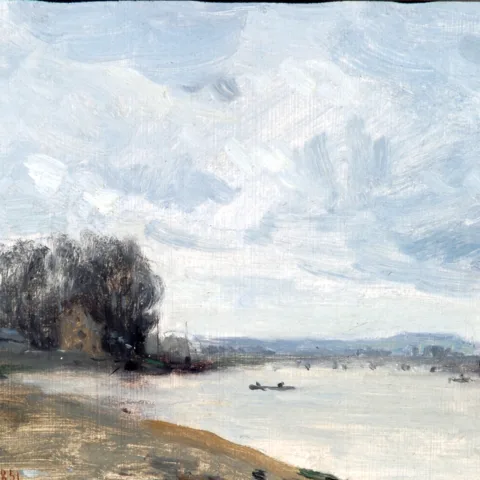The Bowes Museum Blog

Spring Cleaning- Preventive Conservation in Action
In the last six weeks you may have seen us working in the art galleries on the second floor. Myself, Linda and Tor have been carefully condition checking and dry cleaning each of the 350+ paintings hanging in the galleries. This is part of the museum’s preventive conservation programme of work and is by no means a small task, as some paintings are hung approximately 6m in height which means we have had to scale tower scaffolding just to reach them.
Over time, dust and other pollutants deposit on the surface of artworks and this occurs more rapidly in public spaces. These particles are hygroscopic and attract water to the surface which can result in dirt particles permanently bonding to the surface. Water also encourages chemical reactions such as oxidation and hydrolysis, resulting in more rapid deterioration of the artwork materials over time. Ultimately this leads to the aesthetic value of the painting being obscured and in the future it will require more invasive and sometimes costly conservation treatment to reveal the true and original surface.

Frame before and after cleaning
In order to maintain our collection we use preventive conservation techniques to assess, control and slow down the rate of deterioration of artworks and objects over time. This means we are preventing damage before it occurs, rather than after we see a problem.
Tor has been dutifully carrying out a condition survey of the artworks with the intent of assessing each painting’s current condition. The purpose of the survey is to track changes in the condition of the painting over time, assess the stability of the environment it is in and use it as a tool to prioritise the need for remedial conservation in the future. It will enable us to plan the way forward with our collections care management and conduct precise actions to keep it preserved as best as possible.
We can gain a range of useful information about the collection through this process but have adapted the survey form to be effective based on our conservation needs, as well as to be accurate and avoid any potential biases if different persons are conducting an assessment. On average 10 minutes were spent in front of every single painting to grade their condition taking photographs and written records for documentation purposes. An experienced eye is necessary for such a task in order to look for common problems or identify unusual issues across the surface. Typically the artwork is assessed using a magnifier glass and tools such as a torch to provide raking light which emphasizes the surface topography.

Tor condition checking a painting
If the painting and frame is deemed stable enough, then loose dust and dirt are removed gently from the surface with soft brushes (pony hair mop brush) and low suction vacuum cleaners. The end of the hoover is covered with cheese cloth as a precaution so that any unforeseen paint or gilding losses are safely captured.

Myself cleaning the surface
It may seem like laborious work but it allows us to maintain and take care of these collections for future generations. We are also very lucky to have a supportive museum team here which has made this project a success.
Besides… when else will you be able to be inches away from masterpieces by Canaletto or even come face to face with Napoleon himself?

Joint effort to clean Napoleon in the gallery
By Kayleigh Fuller, Regional Conservator/Preventive Conservator







